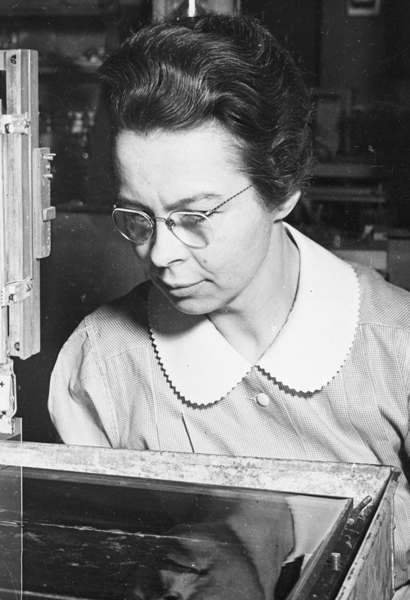

Birth: January 10, 1898
Death: October 12, 1979
Specialty: Physics, Chemistry
Major Contributions:
First woman hired as a scientist at GE
Eight patents
Helped invent Langmuir-Blodgett film for “invisible” glass
Image Source: Smithsonian Institution
Every year, the Academy of Motion Picture Arts and Sciences hands out an award for Best Cinematography. In 1940, that award went to Gone With The Wind. The film was praised for its “crystal-clear” picture, which was achieved because of scientist and researcher Katharine Burr Blodgett.
Born in 1898 in New York, Blodgett spent much of her childhood in France, returning to the U.S. at 14 to enroll in a private school. She attended Bryn Mawr, earning her B.A. in 1917. Just before graduation, she toured a General Electric plant and met Irving Langmuir, a research chemist. Langmuir advised Blodgett that she needed more education to work for him and so she went to University of Chicago, earning her master’s degree in a single year. She published her first paper at 21, and became the first woman scientist hired at a GE research lab in 1918.
In 1924, she took a break from work at G.E. to pursue her doctorate, becoming the first woman to earn a Ph.D. in physics from Cambridge University in 1926, she then returned to GE, where she frequently worked with Langmuir.
Langmuir’s research largely focused on monomolecular coatings, and Blodgett expanded on his methods to create a technique known as the Langmuir-Blodgett trough. This method eventually was used to cover glass, which made the glass more “invisible.” The visible light reflected by the layers of film coating on the glass canceled the reflections created by the glass, which made it extremely useful for eyeglasses, submarine periscopes, and of course, for making movies. Gone With the Wind was the first Hollywood film to use the glass, and a new era in motion pictures was born.
Blodgett was issued eight patents during her career, and published 30 technical papers. Her work included improvements on light bulbs, inventing poison gas absorbents, and improving smokescreens. She was awarded the Francis Garvan Medal from the American Chemical Society, and was a fellow in the American Physical Society, among many other honors. At her death in 1979, one of her coworkers recalled that “the methods she developed have become classical tools of the science and technology of surfaces and films. She will be long — and rightly — hailed for the simplicity, elegance, and the definitive way in which she presented them to the world.”
Written by Mary Ratliff
Sources:
Wikipedia: Katherine Burr Blodgett
Edison Tech Center: Katherine Burr Blodgett
See Also:
Encyclopdia.com: Katharine Burr Blodgett
